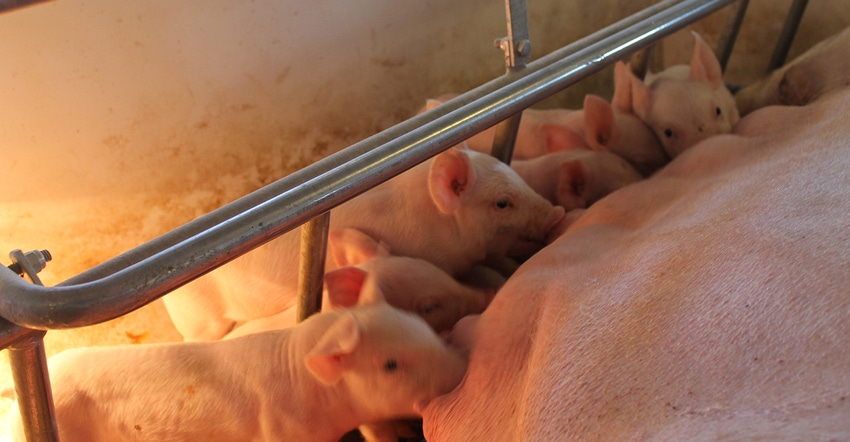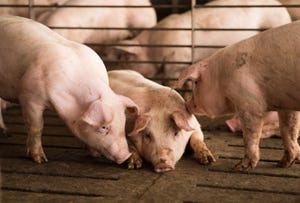The genetics of piglet survival
A threshold level of sow milk production is needed to ensure ample nutrients for piglets nursing the sow.
April 4, 2024

By Mark Knauer, North Carolina State University
Heritability can be defined as the proportion of variation within a trait that can be attributed to inherited genetic factors (Falconer and Mackay, 1996). A heritability estimate ranges between 0 and 1 where an estimate of < 0.10 may be considered low and a heritability of > 0.30 might be considered high. Genetic correlations range from -1 to 1 with zero indicating no genetic association between two traits and a genetic correlation close to -1 or 1 meaning two traits are very similar.
Piglet survival
Piglet survival can generally be defined as the number of piglets weaned divided by the total number of piglets born × 100. Piglets that do not survive until weaning are generally stillborn or die during lactation. Mummified fetuses may also be observed at birth, yet these occurrences are not commonly included in the calculation of piglet survival (Grandinson et al., 2002; Arango et al., 2006; Nielsen et al., 2013; Obermier et al., 2023). In the U.S., piglet survival has been reported to range from 77 to 79% in the commercial industry (Knauer and Hostetler, 2013). Hence industry improvements in piglet survival would enhance animal well-being and farm profitability.
Genetic selection for litter size at birth may impair both piglet survival and piglet quality. Genetic correlation estimates suggest selection for increased total number of piglets born would reduce piglet survival (Rothschild and Ruvinsky, 2011, Nielsen et al., 2013; Putz et al., 2015), decrease average piglet birth weight (Rothschild and Ruvinsky, 2011, Putz et al., 2015), diminish average piglet weaning weight (Huby et al., 2003) and lower the number of available functional teats per piglet (Knap et al., 2023). Hence these results outline the importance of multiple trait selection to balance unfavorable genetic associations with selection for increased litter size.
Genetically enhancing piglet survival may be accomplished through multiple strategies. One approach is to select directly for piglet survival. Grandinson et al. (2002) and Arango et al. (2006) reported heritability estimates for piglet survival (as a trait of the piglet) of 0.05 and 0.03, respectively. Others have evaluated piglet survival as a trait of the sow. Nielsen et al. (2013) and Obermier et al. (2023) estimated the heritability of piglet survival at 0.09 to 0.10 and 0.18, respectively. Hence genetic selection for piglet survival appears feasible, especially as a trait of the sow. Besides direct selection for piglet survival, geneticists may also choose to select on the component traits of piglet survival.
In the simplest of terms, the trait piglet survival may be divided into farrowing survival and preweaning survival. Heritability estimates of farrowing survival averaged 0.07 (Rothschild and Ruvinsky, 2011). In agreement, Kapell et al. (2011) and Leite et al. (2021) reported heritability estimates for farrowing survival ranging from 0.05 to 0.13 and 0.09, respectively. For preweaning survival, heritability estimates averaged 0.05 (Rothschild and Ruvinsky, 2011). Similarly, Leite et al. (2021) showed a heritability estimate for preweaning survival of 0.08. While these two component traits of piglet survival appear to be heritable, other associated traits provide additional approaches to enhancing piglet survival. Specifically, traits that enhance piglet nutrient access may be used to improve piglet survival.
Piglet nutrient access
Adequate piglet vitality helps ensure early nutrient consumption needed for survival. At birth, colostrum provides energy and immunoglobins (Le Dividich et al., 2005). Hence, the ability of a piglet to consume adequate colostrum the first 24 hours of life is highly related to its livability (Wiegert et al., 2017). Genetic selection to enhance piglet vitality appears feasible. Stratz et al. (2016) and Schodl et al. (2019) reported heritability estimates for vitality score at birth of 0.03 to 0.07 and 0.11, respectively. Schodl et al. (2019) further reported improved litter vitality score was genetically associated with lower total number born (rg = -0.68) and lower preweaning mortality (rg = -0.65). Hence these results indicate the farrowing process is genetically associated with piglet survival. Further support for this statement comes from Hellbrügge et al. (2008). Hellbrügge et al. (2008) found a genetic correlation between stillborn piglets and preweaning survival of -0.54. This indicates a lower number of stillborn piglets at birth was associated with enhanced preweaning survival. Taken together, these studies suggest genetically reducing stillborns and improving piglet vitality would enhance piglet survival.
A sufficient birth weight helps guarantee piglets are able consume colostrum at birth. At the phenotypic level, the association between individual piglet birth weight and piglet survival is clear. Fix et al. (2010) reported piglets with the lightest birth weights were much less likely to survive the farrowing process or survive throughout the preweaning phase. However, on a litter basis, the genetic association between average piglet birth weight and piglet survival is perhaps of less importance. Rothschild and Ruvinsky (2011) reported genetic correlation estimates between average piglet birth weight with farrowing survival and preweaning survival averaged 0.22 and 0.15, respectively. Similarly, Putz et al. (2015) showed genetic correlation estimates between average piglet birth weight with piglet mortality of -0.14 and -0.13 for Large White and Landrace breeds, respectively. Collectively, these results suggest genetic selection to increase average piglet birth weight would have a relatively small, positive impact towards enhancing piglet survival.
Sow colostrum quantity and quality are potential traits to increase piglet survival. While the genetics of colostrum quantity are not well understood, phenotypic associations suggest enhancing the number of functional teats on a sow would improve sow colostrum yield (Wiegert and Knauer, 2018). Balzani et al. (2016) reported a heritability estimate for colostrum IgG concentration of 0.35. The same authors reported genetic correlations between colostrum IgG concentration with total number born and number born alive of 0.55 and 0.54, respectively. While these positive genetic correlation estimates suggest colostrum IgG would increase with selection for larger litter size, they also suggest that colostrum IgG concentrations (per piglet) may not keep pace with selection for larger litters. Yet Balzani et al. (2016) further found a genetic correlation between number of stillborn piglets with colostrum IgG of -0.44. This result suggests selection to reduce stillborn piglets would enhance colostrum IgG concentrations. Without question, the genetics of sow colostrum yield and colostrum quality warrant further investigation.
A threshold level of sow milk production is needed to ensure ample nutrients for piglets nursing the sow. Fraser (1990) clearly showed litters with decreased preweaning survival had low early weight gain when compared to litters with greater preweaning survival. Perhaps litter weaning weight can serve as an indicator trait for piglet survival. While the trait litter weaning weight is nearly synonymous with piglet quality (Kennedy, 2017), it is also associated with piglet survival. Zindove et al. (2021) reported phenotypic correlations between preweaning survival with litter weaning weight and average piglet weaning weight of 0.32 and 0.10, respectively. In agreement, Huby et al. (2003) showed genetic correlation estimates between preweaning survival with litter weaning weight and average piglet weaning weight of 0.62 and 0.34, respectively. Damgaard et al. (2003) reported a genetic correlation estimate between preweaning survival and average piglet birth weight of 0.02. Taken together, these results suggest litter weaning weight has a greater association with piglet survival than average piglet weaning weight.
A greater number of functional teats amplifies piglet nutrient access perhaps by both enhancing sow colostrum output and reducing variation in piglet colostrum intake (Knauer and Wiegert, 2023). Increased sow functional teat number is clearly associated with enhanced piglet survival (Enfield and Rempel, 1961; Vande Pol et al., 2021; Earnhardt-San et al., 2023; Obermier et al., 2023). Yet Speckman et al. (2021) reported the importance of functional teat number increases as litter size increases relative to functional teat count. Obermier et al. (2023) reported genetic correlation estimates between piglet survival with number of functional teats and number of functional mammary glands of 0.35 and 0.56, respectively. Similarly, Earnhardt-San et al. (2023) estimated genetic correlations between number of piglets weaned with total teat number and functional teat number of 0.25 and 0.50, respectively. In accordance, Balzani et al. (2016) estimated a favorable genetic correlation between total teat number and a measure of piglet mortality (rg = −0.57). In agreement, Pumfrey et al. (1980) reported a positive genetic correlation between total teat number and a measure of piglet survival (rg = 0.27). Collectively, these results demonstrate an increased number of functional teats enhances piglet survival. This association is perhaps stronger in production systems that do not practice split suckling as split suckling is a management practice that can be leveraged to reduce variation in piglet colostrum intake.
In summary, selection for increased litter size has multiple unfavorable associations with piglet survival and piglet quality. Yet there are multiple pathways to genetically enhance piglet survival. Genetic selection can be used to select directly on piglet survival or indirectly on a component trait of piglet survival such as piglet vitality, piglet birth weight, colostrum characteristics, milk yield, or functional teat number. The appropriate component trait for selection may depend on population weaknesses and present genetic variation. Further information on the genetic aspects of piglet survival can be found in a review by Knol et al. (2022). Questions can be directed to Mark Knauer at [email protected].
References:
Arango, J., I. Misztal, S. Tsuruta, M. Culbertson, J. W. Holl, and W. Herring. 2006. Genetic study of individual preweaning mortality and birth weight in Large White piglets using threshold-linear models. Livest. Sci. 101:208-218.
Balzani, A., H. J. Cordell, E. Sutcliffe, and S. A. Edwards. 2016. Heritability of udder morphology and colostrum quality traits in swine. J. Anim. Sci. 94:3636-3644.
Damgaard, L. H., L. Rydhmer, P. Løvendahl, and K. Grandinson. 2003. Genetic parameters for within-litter variation in piglet birth weight and change in within-litter variation during suckling. J. Anim. Sci. 81:604-610.
Earnhardt-San, A. L., K. A. Gray, and M. T. Knauer. 2023. Genetic parameter estimates for teat and mammary traits in commercial sows. Animals. 13(15):2400.
Enfield, F. D., and W. E. Rempel. 1961. Inheritance of teat number and relationship of teat number to various maternal traits in swine. J. Anim. Sci. 20:876-879.
Falconer, D. S., and T. F. C. Mackay. 1996. Introduction to Quantitative Genetics, Ed 4. Longmans Green, Harlow, Essex, UK.
Fix, J. S., J. P. Cassady, J. W. Holl, W. O. Herring, M. S. Culbertson, and M. T. See. 2010. Effect of piglet birth weight on survival and quality of commercial market swine. Livest. Sci. 132:98-106.
Fraser, D. 1990. Behavioural perspectives on piglet survival. J. Reprod. Fertil. Suppl. 40:355-370.
Grandinson, K., M. S. Lund, L. Rydhmer, and E. Strandberg. 2002. Genetic parameters for the piglet mortality traits crushing, stillbirth and total mortality, and their relation to birth weight. Acta Agric. Scand. A. Anim. Sci. 52:167-173.
Hellbrügge, B., K. H. Tölle, J. Bennewitz, C. Henze, U. Presuhn, and J. Krieter. 2008. Genetic aspects regarding piglet losses and the maternal behaviour of sows. Part 1. Genetic analysis of piglet mortality and fertility traits in pigs. Animal. 2:1273-1280.
Huby, M., L. Canario, T. Tribout, J. C. Caritez, Y. Billon, J. Gogué, and J. P. Bidanel. 2003. Genetic correlations between litter size and weights, piglet weight variability and piglet survival from birth to weaning in Large White pigs. Proc. 54th Ann. Mtg. of the EAAP. Vol. 31.
Kapell, D. N., C. J. Ashworth, P. W. Knap, and R. Roehe. 2011. Genetic parameters for piglet survival, litter size and birth weight or its variation within litter in sire and dam lines using Bayesian analysis. Livest. Sci. 135:215-224.
Kennedy, E. B. 2017. Estimates of variance components for genetic correlations among swine litter quality traits. MS thesis. North Carolina State Univ., Raleigh.
Knap, P. W., E. F. Knol, A. C. Sørensen, A. E. Huisman, D. Van Der Spek, L. J. Zak, A. G. Chapatte, and C. R. Lewis. 2023. Genetic and phenotypic time trends of litter size, piglet mortality, and birth weight in pigs. Front. Anim. Sci. 4:1218175.
Knauer, M. T., and C. E. Hostetler. 2013. US swine industry productivity analysis, 2005 to 2010. J. Swine Health Prod. 21:248–252.
Knauer, M., and J. Wiegert. 2023. Does the modern sow produce enough colostrum? National Hog Farmer. Informa PLC, Overland Park, KS.
Knol, E. F., D. van der Spek, and L. J. Zak. 2022. Genetic aspects of piglet survival and related traits: A review. J. Anim. Sci. 100(6), skac190.
Le Dividich, J., J. Rooke, and P. Herpin. 2005. Nutritional and immunological importance of colostrum for the new-born pig. J. Agric. Sci. 143:469-485.
Leite, N. G., E. F. Knol, A. L. S. Garcia, M. S. Lopes, L. Zak, S. Tsuruta, F. F. Silva., and D. Lourenco. 2021. Investigating pig survival in different production phases using genomic models. J. Anim. Sci. 99(8), skab217.
Nielsen, B., G. Su, M. S. Lund, and P. Madsen. 2013. Selection for increased number of piglets at d 5 after farrowing has
increased litter size and reduced piglet mortality. J. Anim. Sci. 91:2575-2582.
Obermier, D. R., J. T. Howard, K. A. Gray, and M. T. Knauer. 2023. The impact of functional teat number on reproductive throughput in swine. Trans. Anim. Sci. 7(1), txad100.
Putz, A. M., F. Tiezzi, C. Maltecca, K. A. Gray, and M. T. Knauer. 2015. Variance component estimates for alternative litter size traits in swine. J. Anim. Sci. 93:5153–5163.
Pumfrey, R. A., R. K. Johnson, P. J. Cunningham, and D. R. Zimmerman. 1980. Inheritance of teat number and its relationship to maternal traits in swine. J. Anim. Sci. 50:1057-1060.
Rothschild, M.F. and A. Ruvinsky. 2011. The genetics of the pig. CABI.
Schodl, K., R. Revermann, C. Winckler, B. Fuerst-Waltl, C. Leeb, A. Willam, P. Knapp, and C. Pfeiffer. 2019. Assessment of piglet vitality by farmers—validation of a scoring scheme and estimation of associated genetic parameters. Animals, 9:317.
Speckman, E. C., J. T. Howard, and J. G. Wiegert. 2021. PSI-10 The relationship between litter size and functional teat number at farrowing on litter size at weaning. J. Anim. Sci. 99(suppl_1):223.
Stratz, P., A. Just, H. Faber, and J. Bennewitz. 2016. Genetic analyses of mothering ability in sows using field-recorded observations. Livest. Sci. 191:1-5.
Vande Pol, K. D., R. O. Bautista, A. Olivo, H. Harper, C. M. Shull, C. B. Brown, and M. Ellis. 2021. Effect of rearing cross-fostered piglets in litters of differing size relative to sow functional teat number on preweaning growth and mortality. Transl. Anim. Sci. 5(4), txab193.
Wiegert, J. G., C. Garrison, and M. T. Knauer. 2017. Characterization of birth weight and colostrum intake on piglet survival and piglet quality. J. Anim. Sci. 95(suppl_2):32.
Wiegert, J. G., and M. T. Knauer. 2018. 98 Sow Functional Teat Number Impacts Colostrum Intake and Piglet Throughput. J. Anim. Sci. 96(suppl_2):51-52
Zindove, T. J., T. Mutibvu, A. C. Shoniwa, and E. L. Takaendesa. 2021. Relationships between litter size, sex ratio and within-litter birth weight variation in a sow herd and consequences on weaning performance. Trans. Anim. Sci. 5(3), txab132.
You May Also Like



